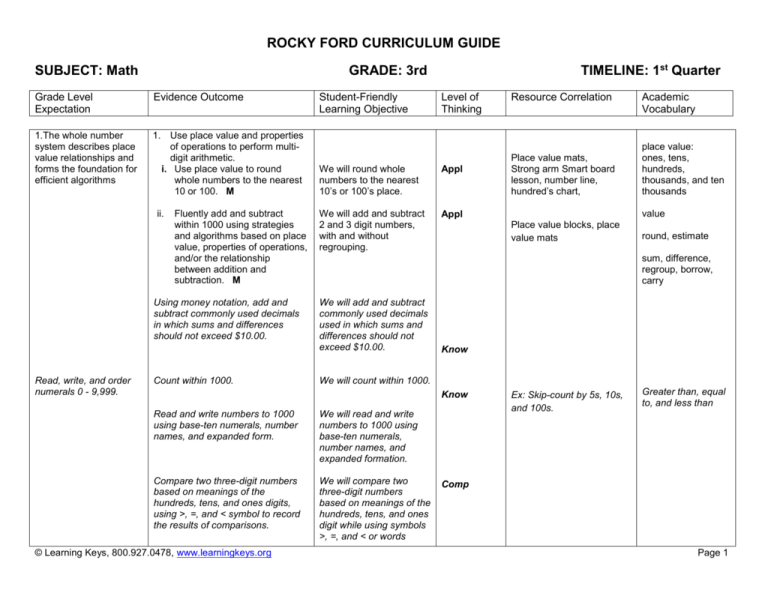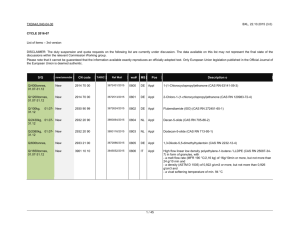Math 3rd Grade 1st Quarter
advertisement

ROCKY FORD CURRICULUM GUIDE SUBJECT: Math Grade Level Expectation Evidence Outcome 1.The whole number system describes place value relationships and forms the foundation for efficient algorithms 1. Use place value and properties of operations to perform multidigit arithmetic. i. Use place value to round whole numbers to the nearest 10 or 100. M ii. Fluently add and subtract within 1000 using strategies and algorithms based on place value, properties of operations, and/or the relationship between addition and subtraction. M Using money notation, add and subtract commonly used decimals in which sums and differences should not exceed $10.00. Read, write, and order numerals 0 - 9,999. TIMELINE: 1st Quarter GRADE: 3rd Count within 1000. Student-Friendly Learning Objective Level of Thinking We will round whole numbers to the nearest 10’s or 100’s place. Appl We will add and subtract 2 and 3 digit numbers, with and without regrouping. Appl Place value mats, Strong arm Smart board lesson, number line, hundred’s chart, Academic Vocabulary place value: ones, tens, hundreds, thousands, and ten thousands value Place value blocks, place value mats round, estimate sum, difference, regroup, borrow, carry We will add and subtract commonly used decimals used in which sums and differences should not exceed $10.00. Know We will count within 1000. Know Read and write numbers to 1000 using base-ten numerals, number names, and expanded form. We will read and write numbers to 1000 using base-ten numerals, number names, and expanded formation. Compare two three-digit numbers based on meanings of the hundreds, tens, and ones digits, using >, =, and < symbol to record the results of comparisons. We will compare two three-digit numbers based on meanings of the hundreds, tens, and ones digit while using symbols >, =, and < or words © Learning Keys, 800.927.0478, www.learningkeys.org Resource Correlation Ex: Skip-count by 5s, 10s, and 100s. Greater than, equal to, and less than Comp Page 1 ROCKY FORD CURRICULUM GUIDE SUBJECT: Math Grade Level Expectation TIMELINE: 1st Quarter GRADE: 3rd Evidence Outcome Student-Friendly Learning Objective Level of Thinking Resource Correlation Academic Vocabulary greater than, equal to, or less than. Represent the digits of a three-digit number as hundreds, tens, and ones. 3. Multiplication and division are inverse operations and can be modeled in a variety of ways d. Solve problems involving the four operations, and identify and explain patterns in arithmetic iii. Assess the reasonableness of answers using mental computation & estimation strategies including rounding.C iv. Identify arithmetic patterns (including patterns in the addition table or multiplication table), and explain them using properties of operations. C © Learning Keys, 800.927.0478, www.learningkeys.org We will represent the digits of a three-digit number as hundreds, tens, and ones. We will determine if an answer is reasonable by using mental math and estimation. Be will identify and extend patterns using addition and subtraction and explain the rule. Comp Analysis Mental math strategies, number lines, Ex: Fluently add and subtract within 20 using mental strategies. Ex: Know from memory all sums of two one-digit numbers. Ex: Use estimation strategies with whole numbers prior to performing the operations of addition and subtraction (for example, front-end estimation, estimation by rounding, friendly numbers, flexible rounding, clustering). reasonable, determine, estimate, front-end estimation, rounding, sum, difference, product, factor, quotient, number sentence, mental math, explain pattern, input/ output table, rule, operation, explain Appl Addition table, hundred’s chart, Page 2 ROCKY FORD CURRICULUM GUIDE SUBJECT: Math Grade Level Expectation 3. Time and attributes of objects can be measured with appropriate tools Evidence Outcome ii. c. Using concrete materials or pictures identify different combinations of coins up to $0.99. Student-Friendly Learning Objective a. Solve problems involving measurement and estimation of intervals of time, liquid volumes, and masses of objects. i. 3. Multiplication and division are inverse operations and can be modeled in a variety of ways TIMELINE: 1st Quarter GRADE: 3rd v. Tell and write time to the nearest minute. M Measure time intervals in minutes. I Model strategies to achieve a personal financial goal using arithmetic operations. I Solve word problems involving dollar bills, quarters, dimes, nickels, and pennies, using $ and cent sign symbols appropriately. Identify whether a given number is odd or even. Determine whether a group of objects (up to 20) has an odd or even number of members by pairing objects or counting them by 2s. © Learning Keys, 800.927.0478, www.learningkeys.org Level of Thinking Comp We will tell and write time to the nearest minute. Resource Correlation Student clocks, Appl We will figure elapsed time to the nearest minute. Student clocks, We will model how we will achieve our financial goal using coins, bills, and arithmetic operations. Appl We will solve word problems involving dollar bills, quarters, dimes, nickels, and pennies, using $ and cent sign appropriately. Appl We will identify whether a given number is odd or even. Know We will determine if groups of objects (up to 20) has an odd or even number by pairing the objects or counting them by 2s. Appl Coins, bills, Social Studies book Academic Vocabulary minute, second, hour, a.m., p.m., quarter after, 15 minutes after, 15 minutes til, quarter til, half past, 30 minutes after Model, penny, nickel, dime, quarter, half dollar, dollar Odd, even Page 3 ROCKY FORD CURRICULUM GUIDE SUBJECT: Math Grade Level Expectation TIMELINE: 1st Quarter GRADE: 3rd Evidence Outcome © Learning Keys, 800.927.0478, www.learningkeys.org Student-Friendly Learning Objective Level of Thinking Resource Correlation Academic Vocabulary Page 4








